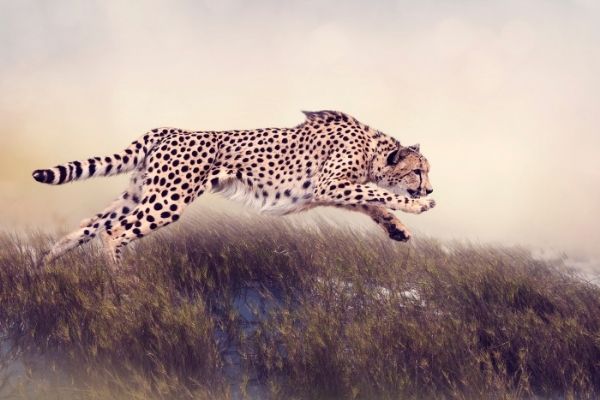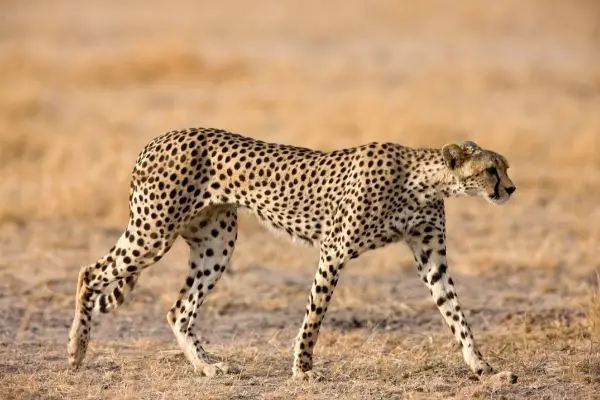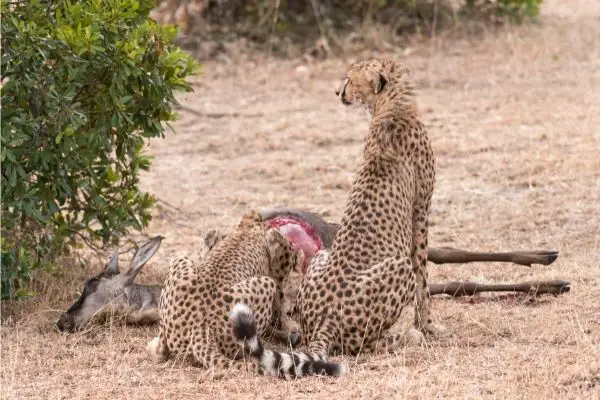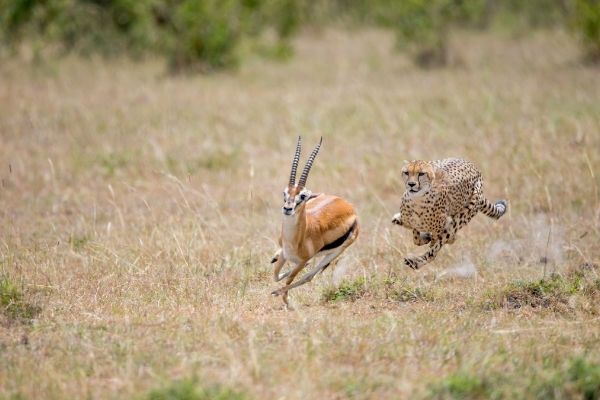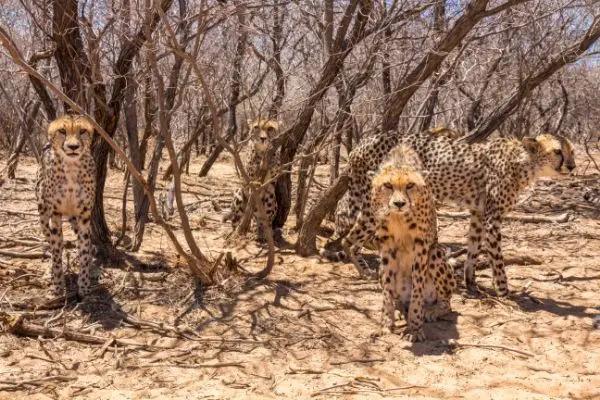There are four sub-species of Cheetah and Northwest African Cheetah is critically endangered along with Asiatic Cheetah. Here we have compiled complete Northwest African Cheetah Facts that will help you in learning all about the Northwest African Cheetah. You are going to learn about its scientific name, its diet, habitat, speed, adaptations, enlargement, population, predators and many other interesting facts about the Northwest African Cheetah.
Northwest African Cheetah Facts
The Northwest African cheetah is a subspecies indigenous to the Sahara desert and Sahel. It is also known as the Saharan cheetah. They have about similar body shapes as that of the sub-Saharan cheetah, however, they are somewhat smaller in size. They also have smaller skulls as compared to sub-Saharan cheetahs.
Saharan cheetahs have quite different appearances from other African cheetahs. They have shorter and almost white coats. The spots on their coats are black on the spine that gradually fades to light brown on the legs. They also have very few or sometimes no spots on the face. Tear strips on their face are also often missing.
In 1913, German zoologist Max Hilzheimer described the Northwest African cheetah under the scientific name of Acinonyx hecki. In 2008, the IUCN Red List listed this subspecies as Critically Endangered.
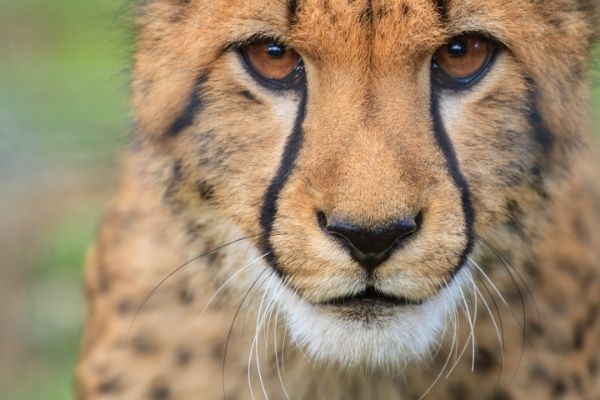
Northwest African Cheetah Scientific Name
Max Hilzheimer, a German zoologist, gave the scientific name to the subspecies in 1913. The scientific name of the Northwest African cheetah is Acinonyx jubatus hecki.
Northwest African Cheetah Diet
Like other cheetah subspecies, the Northwest African cheetah is also an obligate carnivore and fulfills more than 70% of its dietary requirements from the meat of other animals. It exists at the top of the food chain in its habitat range.
Antelopes, which are adapted to the aired environment, are the major prey of the Northwest African cheetah. It includes addax, Dorcas gazelle, dama gazelle, and rhim gazelle. They also eat smaller mammals like hares.
Learn more: What do cheetahs eat
Northwest African Cheetah Habitat – Where Do Northwest African Cheetahs Live
The Northwest African cheetah occurs in various habitats, however, they are now mainly restricted to desert environments. They live in small fragmented populations in the western and central Sahara and the Sahel. They were once widely distributed across North-Western Africa, however, they now occur only in the 9% of their former habitat range.
They are known to be found currently in the countries of:
- The central African Republic
- Chad
- Mali
- Algeria
- Benin
- Burkina Faso
- Niger
The Northwest African cheetah is believed to be regionally extinct in Morocco, Guinea, Guinea-Bissau, Senegal, Sierra Leone, Ivory Coast, Ghana, and Western Sahara.
In Mali, the Saharan cheetahs were observed in the 1990s in Adrar des Ifoghas and the Kidal Region. In Niger, a camera trap photographed a Saharan cheetah in Termit Massif in 2010.
Northwest African Cheetah Speed
Just like other cheetah subspecies, the Northwest African cheetah is also the fastest animal on the land. Cheetahs can sprint at speeds of up to 120 kilometers per hour (75 miles per hour). They can accelerate to 97 kilometers per hour (60 miles per hour) in just 3 seconds. This ability makes them even faster than most sports cars.
Learn more: How fast can a Cheetah run
Northwest African Cheetah Adaptations
The following are the major physical and behavioral adaptations of the Northwest African cheetah:
Physical Adaptations
- Paws: As compared to other felids, cheetahs have narrow paws that resemble the paws of dogs. Such paws have minimum contact with the ground during fast sprints. They also have semi-retractable and slightly curved claws, which are not very sharp. Their claws serve like running spikes, which increase traction while approaching prey. They also have ridges along with the footpads, which additionally increase their traction and serve like tire treads.
- Skeleton: Cheetahs have a well-adapted lightweight skeleton, aerodynamic body frame, and long bones of legs and feet. They also have a highly flexible spine, which enables them to make suden, fast, and long strides.
- Legs: Cheetahs have long and leaner legs as compared to other big cats. Their legs also have spring-like ligaments, which aid in endurance. Such legs enable cheetahs to lift all their four feet off the ground and cross them below their bodies while jumping, just like a horse. A single stride of a cheetah covers about 23 feet, which is around the same distance that a bigger race-horse covers in a full stride.
- Large Heart, Lungs, Liver, and Other Organs: Cheetahs have a well-adapted large heart, liver, lungs, bronchi, adrenals, and arteries. Such organs are essential for cheetahs as they depend on their fiery speed to capture prey. Cheetahs also have well-adapted enlarged nostrils and large, air-filled sinuses, through which they can intake large quantities of oxygen during rapid acceleration. The special respiratory system of a cheetah allows it to take 150 breaths per minute (the normal rate is 60 breaths per minute) during fast running.
- Muscles: Cheetahs have fast-twitch muscle fibers, which provide them with power and endurance. The concentration of these specialized fibers is 20% higher in cheetahs as compared to other fast-running animals, such as horses and greyhounds. They use their speed and acceleration to chase down and capture prey.
Behavioral Adaptations
- Northwest African cheetahs show several behavioral adaptations to survive in the harsh climate of the Sahara desert, where rainfall is irregular, water is hardly available, and daytime temperature exceeds 40 ℃ (104 ℉). Two camera trap surveys in the Ahaggar massif revealed that cheetahs in this region are mainly nocturnal and remain active between sunset and early morning. They also exist at lower density and travel greater distances as compared to other cheetah subspecies living in the savannah.
- Northwest African cheetahs also live without having any direct access to water. So they use the blood of their prey as an indirect source of water.
Why Is The Northwest African Cheetah Endangered
The Northwest African cheetah is Critically Endangered on the IUCN Red List. Like other cheetahs, the major causes of their endangerment may be climate change, habitat destruction, and human hunting. Their genes also pose threats to their continued survival.
Just like other cheetah subspecies, Northwest African cheetahs also have a very lower rate of reproduction, which means they are not always able to reproduce. With a very small number of offspring, their population does not grow. And so they are not able to adapt to changes occurring in the environment.
How Many Northwest African Cheetahs Are Left – Northwest African Cheetah Population
The reliable data on the population status and distribution of the Northwest African cheetah is insufficient. In 2008, their population was suspected to consist of less than 250 adult individuals.
Another survey estimated the population of this subspecies as 457 individuals from 2007 to 2012, in West, Central, and North Africa, in the region of 1,037,322 km² (400,512 square miles). This estimation included 238 individuals in the Central African Republic and Chad, 191 individuals in Algeria and Mali, and 25 individuals in the transboundary of the W National Park, Arli National Park, and Pendjari National Park in Benin, Burkina Faso, and Niger.
In 2016, the estimated largest population of the Northwest African cheetahs consisted of 191 individuals, which occurred in the Adrar des Ifoghas (Mali), Ahaggar, and Tassili n’Ajjer in south-central Algeria and northeastern Mali. In Niger, populations exist in the Ténéré desert and the southern savannah area of the W National Park. In Togo, the records of their existence date back to the 1970s.
A survey was carried out in the North Region of Cameroon between January 2008 and May 2010, in which no Northwest African cheetah was recorded. Camera traps were set up in Ahaggar National Park (south-central Algeria) between August 2008 and November 2010 and recorded 4 individuals. In the same park, an Algerian naturalist photographed a single cheetah in 2020 at the site of the Atakor volcanic field.
Northwest African Cheetah Predators
It is unknown what the predators of Northwest African cheetahs are. Cheetah is itself an obligate carnivore and an apex predator of its habitat range. However, their cubs are vulnerable to predators. Major carnivores found in the habitat range of the Northwest African cheetah are striped hyena, spotted hyena, some species of snakes, and lions in the Sahel region (as lions are not found in the Sahara desert). These animals may be a threat to their cubs.
Northwest African Cheetah Interesting Facts
- The Northwest African cheetah is one of the rarest big cats in the world.
- It is also called the Saharan cheetah as it is native to the Sahara desert and Sahel in Africa.
- The Northwest African cheetah has a light color coat with fewer spots as compared to other subspecies of a cheetah. It also often has no tear strips.
- In appearance, it resembles the sub-Saharan cheetah except that it is slightly smaller.
- Due to the harsh habitat, the Saharan cheetah has a special ability to survive in extreme conditions, such as water scarcity and high temperatures (40 ℃ or 104 ℉ in the daytime).
- Saharan cheetah fulfills most of its water requirements from the blood of its prey, as water is scarce in its habitat range.
- The population of Northwest African cheetah was estimated to be 457 individuals between 2007 and 2012 in an area of 1,037,322 km². However, this number might be short or large because the reliable data on the population status and distribution of this subspecies is insufficient.
- In 2008, the population of this subspecies was suspected to be less than 250 adult individuals. That is why the IUCN Red List included the Northwest African cheetah in the list of Critically Endangered species in June 2008.
